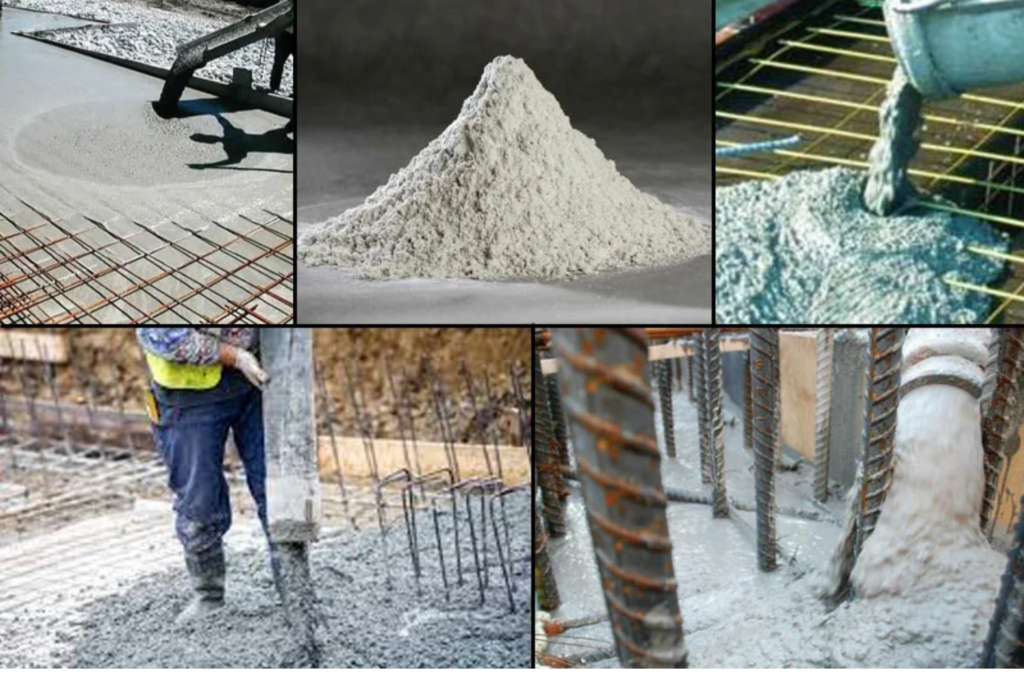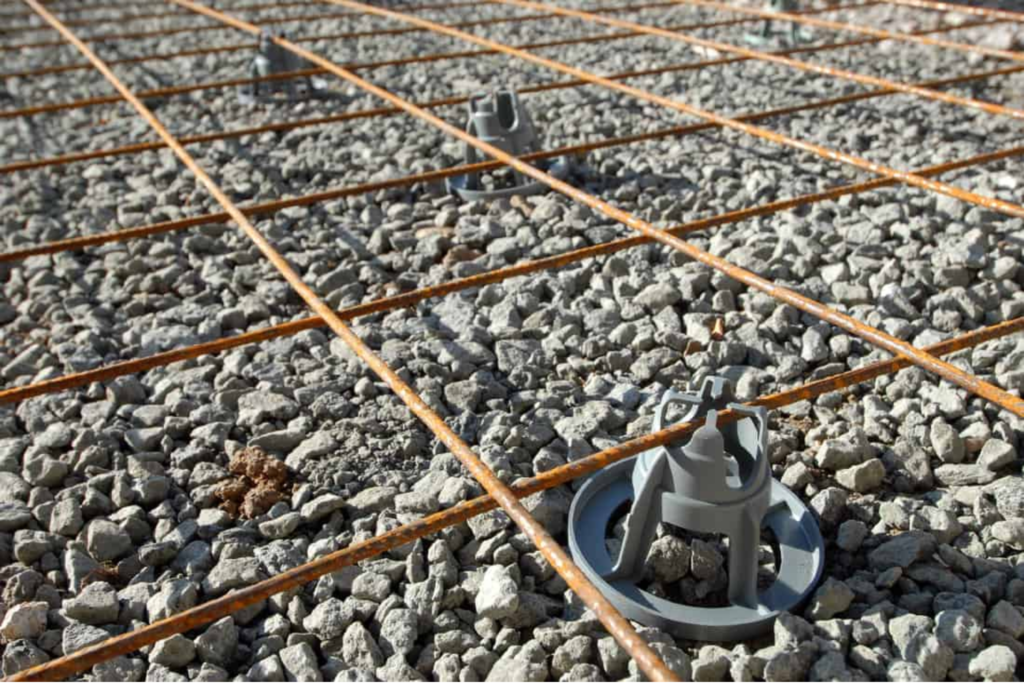Welcome to the fascinating world of construction materials, where concrete plays a pivotal role in shaping our infrastructure. In this post, we’ll dive into the critical question: What chemical is used to harden concrete? Concrete, a blend of aggregates and paste, has been a cornerstone of building for centuries, evolving through time to meet the demands of modern construction. Hardening is a natural process for concrete, but certain chemicals can speed this up, enhancing the material’s strength and durability significantly. These chemical hardeners not only expedite construction projects but also improve the longevity and resilience of structures. Join us as we explore the science behind these powerful additives, their applications, and the profound impact they have on construction timelines and building quality.
Chemical hardeners are used to accelerate the hardening process of concrete, enhancing its strength and durability. Commonly used chemicals include Calcium Chloride, Silica Fume, and Fly Ash. These additives react with the concrete to speed up the curing time, making it quicker to achieve full strength and allowing faster continuation of construction projects. Chemical hardeners are essential for modern construction, improving the efficiency and longevity of concrete structures in both residential and commercial applications.
Table of Contents
Understanding Concrete
Concrete is much more than just a building material; it’s a fundamental component that has shaped our infrastructure and supported our communities for centuries. In this section, we’ll delve into what concrete is, how it has evolved over time, and the intricacies of how it hardens.
What is Concrete?
Concrete is a composite material, which consists primarily of a binder (cement), aggregates (sand, gravel, or stone), and water. When mixed together, these ingredients initiate a chemical process known as hydration, where the cement particles react with water, forming a hardened mass. This unique blend makes concrete incredibly durable and versatile, suitable for a variety of construction projects, from bridges and highways to homes and skyscrapers.
The history of concrete dates back to ancient times, with the Romans utilizing a formative type of this material to construct enduring monuments, some of which stand to this day, such as the Pantheon in Rome. Through the ages, the composition and production methods have evolved, leading to today’s modern concrete, which is both stronger and more malleable.
The Basics of Concrete Hardening
Understanding how concrete hardens is essential for anyone involved in construction. The natural hardening process, known as curing, begins as soon as water is added to the mix. During curing, the concrete undergoes a slow, controlled chemical reaction that can take days or even weeks to complete, gradually gaining strength over this period. The conditions under which concrete cures, such as temperature and humidity, play significant roles in the final strength and durability of the material.
To enhance these properties and speed up construction schedules, accelerators are often added to the concrete mix. These chemical additives increase the rate of the hydration reaction, allowing concrete to harden faster and reach its strength sooner. This is particularly beneficial in projects where time constraints are critical, such as in road repairs or in cold weather conditions where natural curing is slower.
The use of accelerators in concrete is a significant advancement in construction technology. Not only do they reduce turnaround times, but they also help in achieving quicker load-bearing capabilities, which is crucial for fast-paced building environments. Understanding both the natural and chemically enhanced processes of concrete hardening can significantly impact the success of construction projects, ensuring structures are built not only to last but also to be constructed efficiently.
This exploration into the essence and evolution of concrete highlights its pivotal role in construction and development. By appreciating both its historical context and modern applications, we gain a deeper insight into how this age-old material continues to support and shape our built environment.

Chemical Hardeners In Concrete
Understanding the specific types of chemical hardeners used in concrete and how they function is crucial for anyone involved in construction or interested in the materials science behind building practices. This section delves into the various chemicals that can expedite the curing process of concrete, offering a clearer picture of their applications and effects.
Types of Chemical Hardeners
Concrete hardeners are additives that improve the properties of concrete during its curing phase, making it faster to reach optimal strength and durability. Here are some of the most commonly used types.
- Calcium Chloride: As one of the most effective and economical hardening accelerators, calcium chloride is frequently used to speed up the hydration process of cement within concrete. This compound helps concrete to harden faster and achieve its strength quickly, which is particularly beneficial in cold weather conditions.
- Pros: Enhances strength development, reduces set time, and is cost-effective.
- Cons: Can cause corrosion of metal reinforcements and is not recommended for prestressed concrete.
- Silica Fume: This is a byproduct of silicon metal or ferrosilicon alloys, which when added to concrete, significantly improves its mechanical properties and durability. Silica fume reduces the porosity of concrete, making it more resistant to harsh chemical attacks.
- Pros: Increases the strength and durability of concrete, reduces permeability, and enhances resistance to sulfates.
- Cons: Higher cost than some other hardeners and requires thorough mixing to achieve uniform dispersion within the mix.
- Fly Ash: Often used as a partial replacement for cement, fly ash comes from the ash produced in power plants. Incorporating fly ash into concrete improves its workability, reduces heat of hydration, and can enhance the ultimate strength of the concrete.
- Pros: Improves workability, reduces concrete costs, and utilizes a byproduct of coal combustion, which can be environmentally beneficial.
- Cons: The quality of fly ash can vary, and low-quality ash may reduce the concrete’s strength.
How Chemical Hardeners Work
The interaction between chemical hardeners and concrete is a fascinating aspect of construction chemistry. Here’s how these hardeners work:
- Chemical Reaction Process: When added to concrete, chemical hardeners react with the water and cement components to form additional hydrates. These hydrates fill up the spaces within the concrete mix, leading to a denser and more cohesive material. The faster formation of these hydrates expedites the curing process, allowing the concrete to achieve its desired strength more quickly.
- Illustrating the Process: Visual aids, such as diagrams or infographics, can be highly effective in showcasing how chemical hardeners work within concrete. These visuals would typically depict the chemical reaction pathways, the formation of hydrates, and the resulting changes in the concrete’s microstructure.
Understanding the types of chemical hardeners and their mechanisms not only assists in choosing the right material for specific projects but also enhances the overall quality of construction by ensuring that the concrete is durable, strong, and fit for purpose. This knowledge is invaluable for builders, architects, and engineers alike, who are aiming to optimize their construction methods and material choices for enhanced structural integrity.

Benefits Of Using Chemical Hardeners
Chemical hardeners are not just additives; they are the unsung heroes of modern construction, drastically enhancing both the physical properties of concrete and the efficiency of construction processes. This section explores the crucial advantages of incorporating chemical hardeners into concrete mixes, focusing on their impact on strength, durability, and the speed of construction.
Strength and Durability
Enhancing Strength and Longevity
One of the most significant benefits of using chemical hardeners in concrete is the substantial increase in its strength and durability. Hardeners such as Calcium Chloride, Silica Fume, and Fly Ash react chemically with the hydration products of cement, forming additional strong compounds that fill up the pores within the concrete. This process not only makes the concrete denser but also significantly tougher, enhancing its load-bearing capacity and resistance to environmental stresses like freeze-thaw cycles, abrasion, and chemical attacks.
Case Studies Showcasing Real-World Effectiveness
A tangible way to understand the impact of chemical hardeners is through case studies of notable construction projects. For instance, the use of Silica Fume in the construction of marine structures, like piers and docks, has shown remarkable resistance against the harsh saline environment, prolonging their structural life. Another example is the use of Fly Ash in highway overpasses, which not only increased the durability of the concrete but also helped in recycling industrial waste products, showcasing an additional environmental benefit.
Speed of Construction
Reducing Setting and Curing Time
The addition of chemical hardeners to concrete mixes alters the rate of hydration of cement. This acceleration in the hydration process significantly reduces the setting time of the concrete, meaning that it reaches sufficient hardness and strength quicker than non-treated mixes. For construction projects, this is a game-changer, allowing for faster removal of formwork and earlier commencement of subsequent construction phases.
Impacting Project Timelines and Cost-Efficiency
By reducing the time it takes for concrete to cure, hardeners substantially decrease overall project timelines. This not only translates to lower labor costs but also minimizes the use of equipment and machinery, leading to reduced operational costs. In large-scale projects, such as the construction of skyscrapers or extensive road networks, the days or even weeks saved can lead to significant financial savings and earlier project completion, potentially leading to earlier revenue generation from the completed structures.
The use of chemical hardeners in concrete is a critical advancement in construction technology, offering enhanced strength, durability, and efficiency. These benefits not only make structures safer and more durable but also contribute to more sustainable and cost-effective construction practices. Whether for small residential projects or large infrastructural developments, the strategic use of chemical hardeners can lead to better outcomes and more resilient structures.

Applications Of Chemical Hardeners In Construction
Chemical hardeners are integral to modern construction practices, not just in commercial and industrial settings, but also in residential projects. These hardeners are added to concrete to accelerate curing, enhance strength, and ensure the longevity of structures. Let’s explore how these powerful additives are employed in both residential construction and large-scale infrastructure projects.
Residential Construction
In the realm of residential construction, chemical hardeners play a pivotal role in building durable homes that withstand the test of time. Homebuilders use chemical hardeners to speed up the construction process without sacrificing quality. For instance, when constructing concrete foundations, driveways, and garage floors, the use of hardeners can significantly reduce the curing time. This allows builders to complete projects faster, which is particularly beneficial in regions with shorter construction seasons due to weather constraints.
Moreover, renovations often benefit from the use of chemical hardeners. In projects that involve laying new concrete floors or repairing existing ones, hardeners can ensure that the renovated sections are ready for use much quicker. This is crucial for minimizing disruption in homes and enabling families to return to their normal routines as soon as possible.
Commercial and Infrastructure Projects
The scale of application takes a significant leap when it comes to commercial and infrastructure projects. Chemical hardeners are indispensable in the construction of bridges, highways, and skyscrapers—structures that not only require a high degree of durability but also need to be built within tight deadlines to minimize disruptions and manage costs.
For example, in bridge construction, hardeners are used to ensure that the concrete sets quickly and develops the required strength to support large loads. This is essential for early stress bearing and timely completion of the project. Similarly, in highway construction, the rapid curing facilitated by chemical hardeners allows for quicker opening of roads to traffic, which is crucial for reducing congestion caused by construction activities.
Skyscrapers also benefit from concrete treated with chemical hardeners. These towering structures face enormous stresses and strains, and the enhanced strength and durability provided by hardeners are critical. The use of such additives in the concrete mix ensures that the structural elements of skyscrapers can withstand the challenges of both the construction process and long-term environmental exposure.
The use of chemical hardeners in concrete is a testament to the advancements in building technology that cater to both practicality and durability. Whether it’s constructing a cozy home or erecting an awe-inspiring skyscraper, these hardeners ensure that the structures not only rise faster but also stand stronger. As construction techniques continue to evolve, the role of chemical hardeners remains crucial in shaping safe and sustainable environments.

Considerations And Challenges
When incorporating chemical hardeners into construction projects, it’s crucial to consider not only the immediate benefits but also the broader environmental and safety implications. This awareness ensures that the use of these chemicals contributes positively to both the built environment and the natural ecosystem, while safeguarding those involved in their application.
Environmental Impact
The use of chemical hardeners in concrete can significantly enhance the material’s properties, such as increasing its strength and reducing the curing time. However, these advantages often come with ecological considerations that need careful assessment. For instance, some chemical hardeners can contain substances that, if not properly managed, may pose risks to the environment. These substances can leach into the soil and water systems, potentially harming wildlife and disrupting local ecosystems.
Moreover, the production of some chemical hardeners involves processes that are energy-intensive and emit a considerable amount of CO2 and other pollutants. As the construction industry moves towards more sustainable practices, it’s essential to choose hardeners that align with green building standards and contribute to the sustainability goals of the project.
Efforts to mitigate the environmental impact of chemical hardeners include.
- Choosing Eco-Friendly Options: Opt for hardeners that are labeled as low-VOC (Volatile Organic Compounds) and are made from recycled materials or naturally occurring substances.
- Proper Waste Management: Implementing strict protocols for handling, recycling, or disposing of chemical hardeners and their containers to prevent environmental contamination.
- Regulatory Compliance: Ensuring all chemical hardener applications meet local and international environmental regulations to minimize ecological damage.
Safety and Handling
The handling and application of chemical hardeners require stringent safety measures to protect the health of construction workers and other stakeholders involved in the building process. Chemical hardeners can be corrosive and toxic, posing risks such as skin burns, respiratory issues, and other serious health problems if handled improperly.
Key safety practices include:
- Personal Protective Equipment (PPE): Workers should wear appropriate PPE, including gloves, goggles, face masks, and protective clothing, to shield against chemical splashes and inhalation of fumes.
- Training and Education: All personnel involved should receive thorough training on the risks associated with chemical hardeners and the correct procedures for safe handling and application.
- Emergency Preparedness: Establishing clear protocols for dealing with spills, exposures, and other emergencies related to chemical hardeners, including having first aid measures and cleanup kits readily accessible.
By addressing these environmental and safety considerations, construction projects can leverage the benefits of chemical hardeners effectively while maintaining commitment to ecological stewardship and worker safety. This approach not only ensures compliance with legal and ethical standards but also enhances the project’s reputation among clients and the broader community.
This section delves into the critical environmental and safety considerations associated with the use of chemical hardeners, emphasizing the need for responsible practices to maximize benefits and minimize adverse impacts. By addressing these issues comprehensively, the content supports informed decision-making and responsible construction practices.

FAQs: About What Chemical Is Used To Harden Concrete?
What is a chemical hardener for concrete?
A chemical hardener is an additive used in the concrete mix to accelerate the curing process and improve the material’s properties such as strength and durability.
How do chemical hardeners work?
Chemical hardeners react chemically with the concrete to speed up the hydration process of the cement, leading to quicker hardening and strength development.
Are there different types of chemical hardeners?
Yes, common types include Calcium Chloride, Silica Fume, and Fly Ash. Each has unique properties and uses depending on the specific requirements of the construction project.
What are the benefits of using chemical hardeners in concrete?
Using chemical hardeners can significantly reduce the curing time of concrete, enhance its strength and durability, and allow faster progression of construction projects.
Can chemical hardeners be used in residential construction?
Absolutely, chemical hardeners are beneficial in residential construction for foundations, driveways, and other structural elements requiring increased durability and reduced curing time.
What are the environmental impacts of using chemical hardeners?
While chemical hardeners can improve construction efficiency, they must be used responsibly as some types can have environmental impacts, such as potential chemical runoff or increased CO2 emissions.
Are there safety concerns with using chemical hardeners?
Yes, safety precautions are necessary when handling chemical hardeners as they can be corrosive and harmful if not used properly. Appropriate protective gear and handling procedures are essential.
How do chemical hardeners affect the longevity of concrete structures?
By improving the strength and density of concrete, hardeners can significantly extend the lifespan of concrete structures, making them more resistant to wear and environmental conditions.
What is the cost implication of using chemical hardeners in concrete?
The initial cost of adding chemical hardeners can be offset by the benefits of faster construction times and reduced labor costs, as well as long-term savings from increased durability.
How do I choose the right chemical hardener for my project?
Selecting the right chemical hardener depends on several factors, including the type of construction, environmental conditions, and specific performance requirements. Consulting with a construction materials expert is recommended to make the best choice for your project.
Conclusion
In conclusion, this exploration of chemical hardeners has highlighted their indispensable role in enhancing the speed, strength, and durability of concrete. These additives, such as Calcium Chloride, Silica Fume, and Fly Ash, are pivotal in meeting the rigorous demands of modern construction by accelerating the curing process and improving the overall quality of concrete structures. For those keen on delving deeper into the subject or with specific project needs, consulting with construction professionals is highly recommended. Looking ahead, the role of construction chemicals is set to become even more crucial as the industry shifts towards sustainable practices. The continuous evolution of these substances promises to not only further the capabilities of concrete but also to advance environmental stewardship within the sector, paving the way for a greener, more sustainable future in construction.
About the Author:
Mike Veail is a recognized digital marketing expert with over 6 years of experience in helping tradespeople and small businesses thrive online. A former quantity surveyor, Mike combines deep industry knowledge with hands-on expertise in SEO and Google Ads. His marketing strategies are tailored to the specific needs of the trades sector, helping businesses increase visibility and generate more leads through proven, ethical methods.
Mike has successfully partnered with numerous companies, establishing a track record of delivering measurable results. His work has been featured across various platforms that showcase his expertise in lead generation and online marketing for the trades sector.
Learn more about Mike's experience and services at https://theleadguy.online or follow him on social media:





















